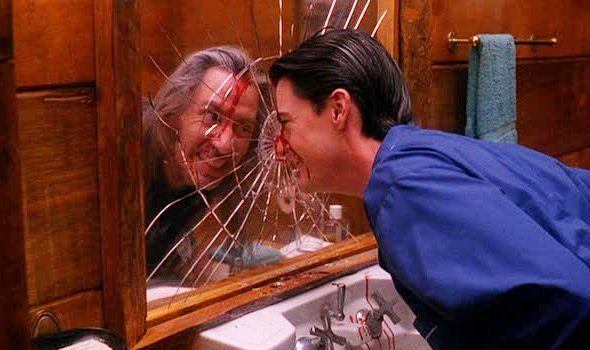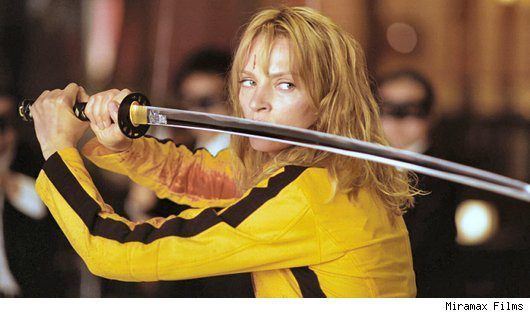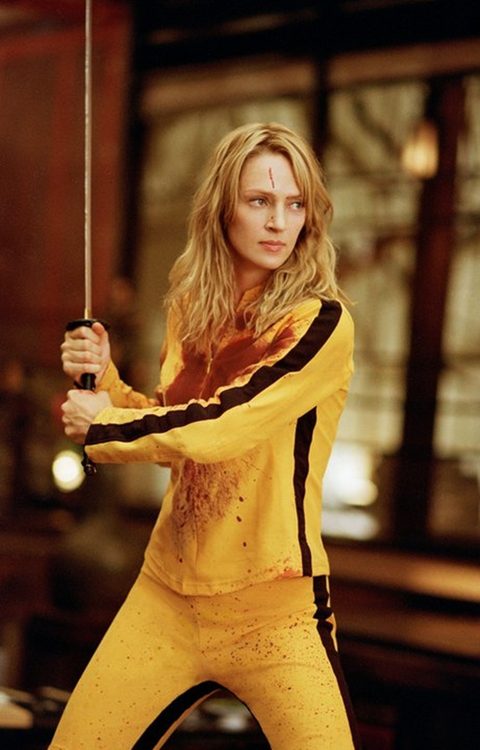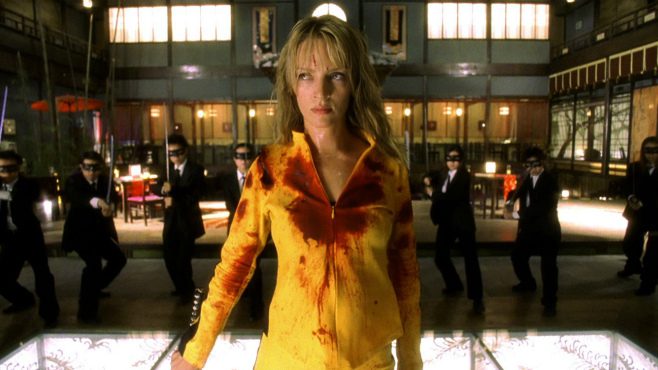
When I was 15 years old, I came to associate evil with a jean-jacketed, gray-haired, man-monster. His name was Bob and although his rapes and murders of young women were restricted to the all-too-real soap opera panning my television screen, he also haunted my room, my house, my space. For those unfamiliar with the lamentably brief series Twin Peaks, Bob is a parasitic entity that inhabits the minds and bodies of men and unearths the darkest evils within them. Although he wanders into and out of bodies like a ghost, the audience gets glimpses of Bob’s human form, and the mundane look of his wrinkled face, globular eyes, and that iconic jean jacket become imposingly malevolent.
The show’s pilot opens with the death of Laura Palmer, a prom queen turned femme fatale, and slowly chronicles the unraveling of dark secrets contained within the small town of Twin Peaks. The series abruptly ends in the second season with the corruption of the innocuous Agent Cooper (played by the beloved and dreamy Kyle MacLachlan), the investigator originally deployed to solve Laura’s death and quell the chaos and loss brought to the community. In the final scene, as MacLachlan gazes into the bathroom mirror, his stellar good-boy looks are reflected back as the unforgettable image of Bob, and we hear his final predatory words, “Where’s Annie? Where’s Annie?”.
as the unforgettable image of Bob, and we hear his final predatory words, “Where’s Annie? Where’s Annie?”.
Not the most hopeful or conclusive ending, but rather a frightening reflection on the pervasive reality of male violence. Bob is ephemeral and ubiquitous all at the same time, invading new spaces and new people, all towards the constant goal of silencing, ravishing, and destroying the female body.
And unlike the classic horror movies or psychological thrillers that stay with you for a few nights until your day-to-day routines diffuse them, Twin Peaks has remained with me over the years. As the years passed, I realized that not only was I haunted by this notion of evil space, I was searching more and more for a resolution—for a representative woman to reclaim that invaded space as her own, to seek revenge against Bob.
I have only found solace in one movie. Not in Laura Croft’s voyeuristic Tomb Raider or the supposed heroines that whimsically dot the Marvel movies. No, I wanted someone who could truly destroy the confines of the space women have been deemed by men to inhabit. And then there she was, clad in yellow: Beatrix Kiddo. I found my peace in Tarantino’s two-parted vindictive masterpiece. Kill Bill may have been about Beatrix Kiddo avenging Bill, but for me, she killed Bob too.
Kill Bill is, in simple terms, a revenge narrative. On the day of Beatrix Kiddo’s (Uma Thurman) wedding, her former lover and boss, Bill, along with four ninja accomplices, murder her entire bridal party and attempt to kill a pregnant Beatrix as well. Four years later, Kiddo awakens from a coma to take vengeance on those who massacred her family and (to her knowledge) killed her then unborn child. The vigilante narrative is nothing new. Thriller: They Call Her One Eye. The Girl with the Dragon Tattoo. The Brave One. The women in these films rely on an essential moral imperative in order to incite violence against another person. I watched these vigilante films with hope, but always walked away feeling disappointed. Perhaps they were a step up from the femme fatales and psychotic housewife tropes that permeated earlier decades, but none of these films amplified the narrative to an extremism that would truly shatter patriarchal paradigms.
The women in these films rely on an essential moral imperative in order to incite violence against another person. I watched these vigilante films with hope, but always walked away feeling disappointed. Perhaps they were a step up from the femme fatales and psychotic housewife tropes that permeated earlier decades, but none of these films amplified the narrative to an extremism that would truly shatter patriarchal paradigms.
When Kill Bill came along, it called into question violent vigilantism as an authentic expression of feminism. The need for provocation in order for a woman’s violence to be justified locates her motivations for violent action in isolated events rather than systemic structural violence. While for men, violence is always a performance of masculinity, for women, violence must be prompted by an individual act: an episode of abuse, a rape, an imprisonment. Often times these movies fall flat. While abuse may be a legitimate incentive for anger and rage, we are presented with a predictable and acute narrative arc of an often oversexualized female whose violence is pathological rather than socially constructed.
The performance of violence in Kill Bill, although provoked by the singular act of Bill’s betrayal, is done in a way that rejects the revenge vigilante narratives that preceded (or even followed) it. Kill Bill has often been critiqued through an aesthetic lens, focusing on the appropriation of classic kung fu flicks and anime narratives, on the emblematic violence Tarantino invented, on the characters as superficial movers of a grander arc. However, beneath these aesthetic layers is a story of a man who forced a woman to choose between a life with her new fiancé and a life as a respected and skilled ninja, between maternity and employment—a trope women have grappled with for decades.
and skilled ninja, between maternity and employment—a trope women have grappled with for decades.
Throughout the film, Kiddo confronts each one of Bill’s accomplices in the massacre. She shoots Copperhead in the kitchen, destroys Cottonmouth in the snow, slays California Mountain Snake in her trailer. It is not just another example of playful aesthetic violence, a typical show of voyeuristic cat fighting, or an acutely motivated act. Rather, these women fight each other, loosely provoked by a revenge narrative, but perhaps more so because it is their job. They are ninjas, and they perform violence in the same way we might see the hypermasculine Dwayne “The Rock” Johnson or Vin Diesel fight in The Expendables (but with better choreography). It is a performance males have been partaking in forever. Here, females are playing the game too.
In the past decade, a new generation of strong female protagonists has emerged, yet each woman remains a mere shell of a character. As Tasha Robinson of The Dissolve recently pointed out, the “strong” female protagonist has become a token character in today’s narrative features. These women (think Valka from The Lego Movie, Gamora in Guardians of the Galaxy, Black Widow in The Avengers) lack complete narrative arcs, often falling by the wayside as male characters rise to the forefront, never quite fulfilling the high expectations put forth by their introductory scenes. They are included simply to avert societal critique. Even those films that seem like feminist disrupters are constructed to placate audiences without challenging industry standards. The Hunger Games might be progressive in its portrayal of Katniss as a strong warrior, but her violent motivations are provoked less by misogyny and more by class oppression, and her narrative ultimately falls back on the “who will she choose?” love story. Edge of Tomorrow presents the viewers with an engaging and intellectual Rita, but concludes the film with Tom Cruise’s William Cage, trained by Rita herself, saving the day, and the world, for that matter. Mad Max, although lauded as a feminist masterpiece, relies on a number of hypersexualized female characters led by Charlize Theron, a protagonist whose shaved head and dress so resemble a man that her strength becomes associated with masculinity, not femininity. While these films are a step in the right direction, I refuse to remain complacent towards or congratulatory of Hollywood’s attempts at satisfying the lowest common denominator. But Kill Bill is not framed so as to disturb systemic misogyny through one token female character; it employs a diverse cast of strong and dynamic female characters, a rarity amongst films today. By the time Kiddo reaches the final confrontation with Bill, she has proven herself to be a resilient and intelligent woman who has defeated a whole host of other strong, angry, and resourceful women.
a man that her strength becomes associated with masculinity, not femininity. While these films are a step in the right direction, I refuse to remain complacent towards or congratulatory of Hollywood’s attempts at satisfying the lowest common denominator. But Kill Bill is not framed so as to disturb systemic misogyny through one token female character; it employs a diverse cast of strong and dynamic female characters, a rarity amongst films today. By the time Kiddo reaches the final confrontation with Bill, she has proven herself to be a resilient and intelligent woman who has defeated a whole host of other strong, angry, and resourceful women.
When Kiddo enters Bill’s home to see the daughter she never knew existed and her ex-lover playing a pretend assassin game, the audience envisions for a moment that Kill Bill may have a twisted romantic ending, that the two killers will fully embrace parental roles and dismiss all the rest. Yet, as the scene progresses, it becomes clear that the ultimate face off between Bill and Kiddo is gradually approaching. But not before a little mansplaining. Kiddo has put her newfound child to bed, has been shot with a temporarily debilitating truth serum, and is now listening to Bill explain to her what he deems the “Superhero mythology.” Superman’s alter ego, Bill expounds, is akin to the alter ego that Kiddo was attempting to adopt by marrying a Midwestern man and leaving the killing business. She is a natural born killer, a Superman that could never pass as a Clark Kent. As Kiddo listens, Bill’s comments are couched in subtle flattery, but in truth reveal his desired control over her identity, her actions, her space. Another man imposing an unwanted identity onto another woman. It is here that Bill truly emerges as the physically and emotionally ravenous Bob.
However, rather than letting him reign, rather than silently submitting, Kiddo kills Bill/Bob with the swoop of her hand, in a move that literally explodes her victim’s heart within minutes. In these final scenes, Kiddo does not simply take down one individual man; she conquers Man as arbiter of a female’s body and mind. As she walks out of Bill’s home, ninja sword draped around her back and daughter in her arms, Kiddo proves herself to be a dynamic woman, to be both warrior and mother.
To be fair, the dynamic woman is not completely invisible from modern day media. The horror genre has perhaps been the most progressive space to explore the boundaries of female agency. Vampire flicks have long been the provocateurs of the limits of female sexuality and maternity. While these films may conclude by castigating a woman’s sexual deviance or rejected femininity, they at least exposed audiences to an alternative type of woman in a seductive and engaging way. The Babadook and A Girl Walks Home Alone at Night are contemporary examples of horror films that are elevating the genre even further, pushing the limits of the feminine space and offering new systemic motivations for violence. However, while horror has always been a genre that explores the limits of femininity,  the superhero action film has almost always functioned as a space to mold expectations of masculinity and homosocial relations. Displays of violence, power, and dominance over women become the locus of patriarchal bonding and male friendship. Superwoman, Catwoman, and the few other female characters that appear on screen are often constructed simply as the female counterpart to an already established male hero, subsuming them under a pre-existing male identity. Kill Bill is revolutionary because it disrupts both content and genre, beautifully showcasing what these superhero-action stories so consistently overlook, while embodying the success of what the genre could achieve.
the superhero action film has almost always functioned as a space to mold expectations of masculinity and homosocial relations. Displays of violence, power, and dominance over women become the locus of patriarchal bonding and male friendship. Superwoman, Catwoman, and the few other female characters that appear on screen are often constructed simply as the female counterpart to an already established male hero, subsuming them under a pre-existing male identity. Kill Bill is revolutionary because it disrupts both content and genre, beautifully showcasing what these superhero-action stories so consistently overlook, while embodying the success of what the genre could achieve.
And so, I wait for another Kiddo to emerge in the coming years. But until then, rather than envisioning Bob’s seething jean jacket, I choose to see yellow spandex. I see a warrior, a lover, a friend, a mother, a recluse, a dichotomy: Beatrix Kiddo. She is not Superman, she is not Superwoman, she is simply and wondrously Woman.
***
Image credits: Featured image, image #2, image #3, image #4, image #5, image #6.




